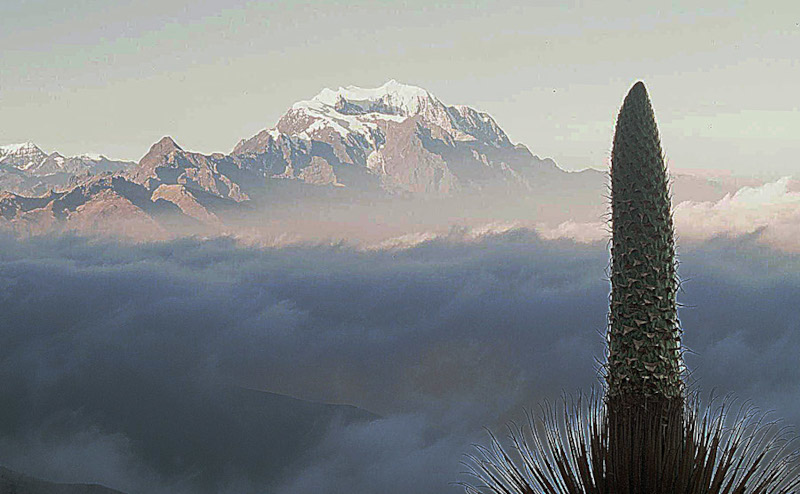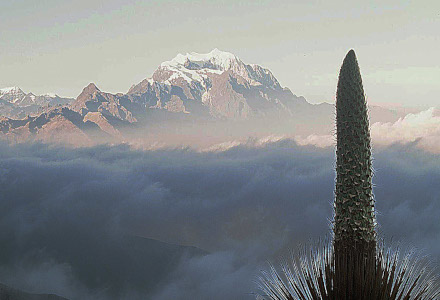
Queen of the Andes Facts
- This astonishing plant represents a most impressive species of Bromeliad that most frequently goes by the informative name of the Queen of the Andes. That’s not the only term used for the amazing plant, though. In fact, it actually goes by several names.
- That’s partly due to the fact that, in the language of the local Indigenous Peoples, known as the Quechua, the marvel’s known by the term of the Titanka. In Spanish, meanwhile, it’s usually referred to by those who know of it as puya de Raimondii.
- Researchers, however, generally use a far more formal, scientific name for the amazing plant. That’s the moderately hard to pronounce term of Puya raimondii. By either term, though, the plant truly stands out from its many relatives around the world.
- The German botanist, Hermann August Theodor Harms holds credit for the name it currently bears. He changed it to its current name in 1928, because another plant already held a very similar name. The original naming, though, happened much earlier.
- In fact, the French scientist Alcide d’Orbigny actually made the first official recognition of it as a separate and distinct species. This noteworthy accomplishment, furthermore, occurred in 1830. The name raimondii honors a 19th-century Italian scientist.
- The IUCN also currently lists the Queen of the Andes as Endangered on its Red List. It earns this status due to several reasons. Its known range forms one factor, as well as habitat loss. Climate change, however, perhaps represents the greatest threat it faces.
Related Articles
Queen of the Andes Physical Description
To be certain, the remarkable Queen of the Andes impresses those who encounter it for a variety of reasons. Chief among those, however, likely comes its sheer size. That’s due to the fact that this fascinating species ranks as the largest of all known bromeliads on earth.
More precisely, exceptional specimens sometimes achieve heights measuring as much as 50 ft (15 m)! Most, though, typicaly reach sizes slightly smaller than this. That overall height, though, is acutally broken down into several separate sections of the beautiful plant.
The trunk of the plant itself typically develops strongly vertically. This feature also attains heights of up to 16 ft (5 m). This part of the plant further generaly manifest a darker brown shade. The bark, additionally, typically manifests a very rough, almost scaly texture.
This portion of the plant also generally possesses a dense covering of unique foliage. Roughly two hundred highly elongated leaves develop, each averaging about 4 ft (1.25 m) in length. Developing spiny in nature, these also average about 3 in (8 cm) in width.
Atop this portion, however, the stunning Queen of the Andes develops its impressive infloresecence. This collection of clusters of flowers itself also develops vertically, ranging from 13 -26 ft (4 – 8 m) in height. The small blooms show white, with a small orange center.
- Kingdom: Plantae
- Phylum: Tracheophyta
- Class: Monocots
- Order: Poales
- Family: Bromeliaceae
- Genus: Puya
- Species: P. raimondii
Queen of the Andes Distribution, Habitat, and Ecology
The very name of the visually impressive Queen of the Andes provides a clear indicator of where in the world this marvel of Nature evolved. That’s because, as indicated, the Angiosperm developed in the Andes Mountains, located in South America.
Within that magnificent mountain range, though, it actually inhabits a comparatively moderate extent of the territory. Groupings of this wonder of evolution appear in only two countries on the continent. It resides within the boundaries of Peru and Bolivia.
Yet the restrictive nature of its habitat range doesn’t simply stop there. That’s due to the fact that it evolved as endemic to a precise range of environmental conditions. It appears at altitudes ranging from 9,800 – 15,700 ft (3,000 – 4,800 m) above sea level.
Its own evolved nature further complicates the chances of the species spreading to other regions. That’s because it eschews more fertile regions. The unique plant actually favors harsh areas consisting mainly of rocky slopes and areas of small, dense shrubs.
Another factor limiting its chances of survival remains the fact the each plant blooms only once in its entire life. Indivual lifespans vary, but averge approximately 80 years. Specimens further typically do not bloom until very near the end of their lives.
The primary mode of pollination for the aptly-named Queen of the Andes is actually birds. These frequently become temporarily ensnared by its spiny fronds, allowing for the transference of pollen. This snaring once led some to believe it was a carnivorous plant.
Species Sharing Its Range
Check out our other articles on 4 Magnificent Alaskan Mammals, Leaf Slug, Lake Superior, Southern Tamandua, Giant Forest Ant, Horn Shark, California red-sided garter snake

